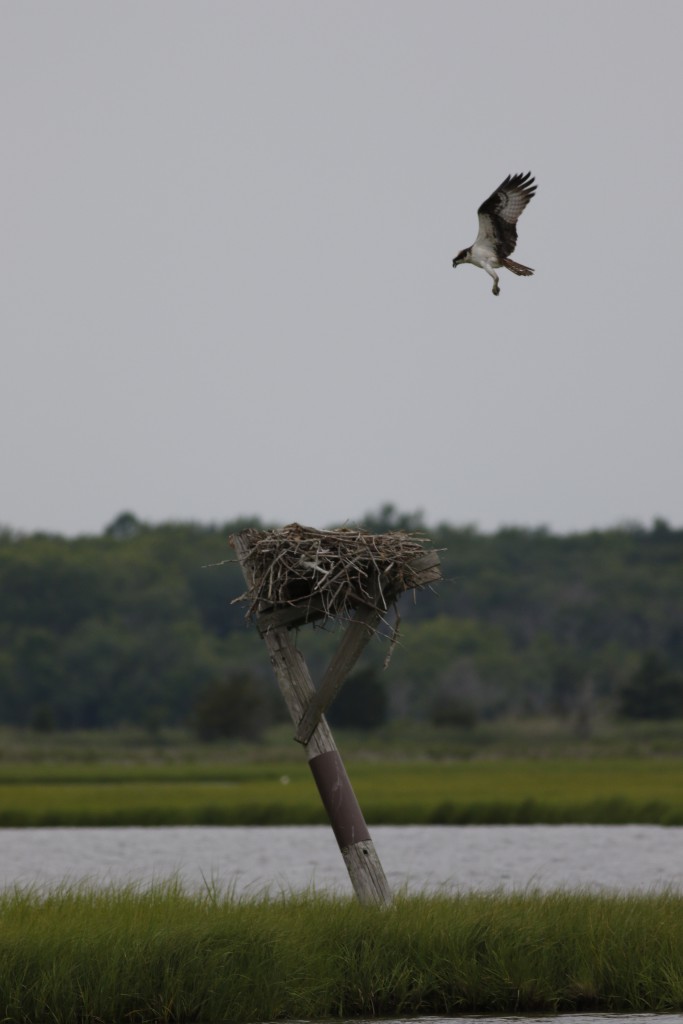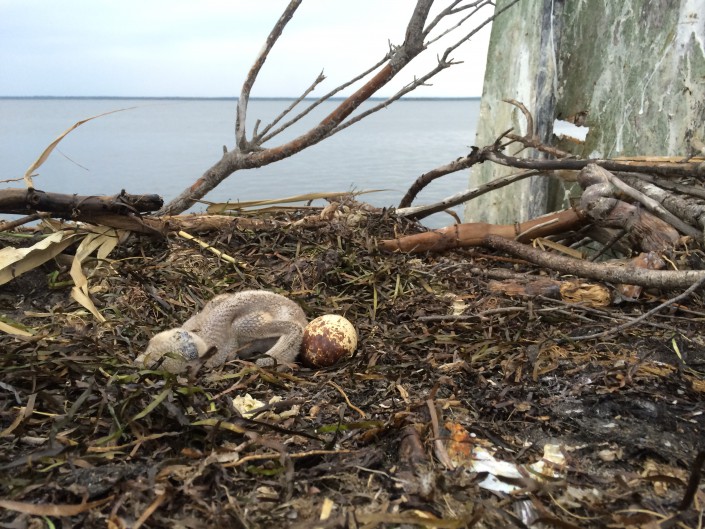Impacts from Severe Weather minimal
Nesting ospreys fared well from June 23rd storms on B. Bay
by Ben Wurst, Habitat Program Manager
We had some pretty insane weather blow through on Tuesday evening. I saw it first hand while driving to Long Beach Island to visit some relatives in town. The storm front brought high winds and driving rain to the area. The National Weather Service has even declared that there was even a water spout in Brant Beach (which was right where I was driving on the LBI Blvd. southward). Winds gusted to 70-80mph blowing all sorts of debris (and lawn furniture) across the road. I immediately pulled over to where I was protected from the wind. While I sat there I thought of all the osprey nests out on the bay with young in them…

At this time of year almost all nests have young. They range in age from only hatchlings to 4 week old nestlings. Some can be easily blown from shallow or weakly built nests and can be easily blown from the top of nesting platforms. This has happened in the past (in 2012 when we had a “derecho” blow through the area in late June) and almost half the young present were blown from their nests (in Absecon).
To get a better idea of what we experienced, I asked Jonathan Carr, with Weather NJ, what we saw. This would also give me a better idea of what to expect when conducted post-storm surveys. “What we saw in SNJ on Tuesday was a bow echo as evident by radar signature. A macroburst hit SWNJ which generated substantial straight line winds that fueled the system all the way to the coast. In addition, multiple rotation signatures were picked up via velocity analysis which sparked the tornado warnings in perfect alignment from PA through SWNJ and ultimately the Jersey Shore. The NWS officially ruled the incident near Brant Beach a waterspout but little damage was done from such. All damage across SNJ was again, from straight line wind gusts which reached 80mph in several locations. Harvey Cedars actually clocked a 92mph wind gust. I wasn’t surprised given that instability and wind parameters were screaming for this to happen in the prior 24 hours, especially with the cold front trigger moving through. These type of winds are disastrous for any coastal wildlife or nesting grounds with open exposures.”
With that news on the weather front, I knew we’d have young ospreys on the ground. On Wednesday I got my first report from Osprey watchers Ray and Leslee on Cedar Run Dock Rd. They noticed the adults acting funny, who were now on the ground and not on the nest (where they were before the storm). I gave Leslee permission to walk out to the nest. She found two 3 week old young on the ground. I had plans that day so I couldn’t make it there until 9pm. But when I met Leslee and Ray the nestlings were still on the ground. We picked them up and put them back into the nest (and we also fed a good amount of mosquitoes!!)

The following day we rallied to get out on our boat to conduct some more “post-storm surveys,” the first of the season. We checked nests from Bonnet Island to Loveladies and Barnegat. A total of 18 active nests were surveyed. At the first nest we checked we found four young (this nest has failed to produce young for the past two years, amazing!)!! The second had two nestlings in the nest and none were found on the ground. GREAT! But, as the clouds moved in the survey took a darker turn… The next nest we checked was empty but had the remains of a very young osprey. Then the next one had two alive in the nest and one dead on the ground (a 14 day old). The next two nests had 2 and 3 young in them and they all looked very healthy. Then at the next nest we saw the whole nest down on the marsh. When we dug through it we found the bodies of two young. They were instantly crushed under the weight of the nest. So sad. The adult female was still sitting on the nest, surely hoping they were found alive. 🙁 It is now too late to get out to other areas to rescue young. I have learned that young are NOT fed when they are grounded. So there is little chance that any young would still be alive if found on the ground. Future surveys will determine how many other areas were affected by the strong storms.
Despite the gloomy outcome, nests in this severely impacted area had overall good results. We counted a total of 27 young from 18 active nests which gives us an average productivity rate of 1.5 young (per active-known-outcome nest). This is almost twice the level needed to sustain the population. Most young were around 17 days old. Only five were banded for future tracking.
It’s too early to tell how the entire population will fare this year. It could be a down year, with reports of no large schools of menhaden that are close to shore. Menhaden (bunker) are one of the most crucial food sources for many coastal species, including osprey.
Photos from the Survey:








